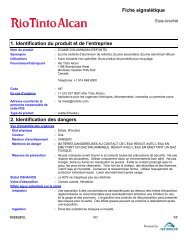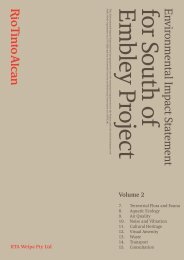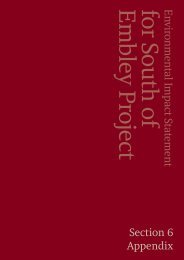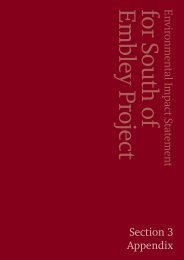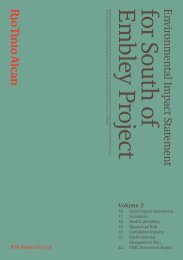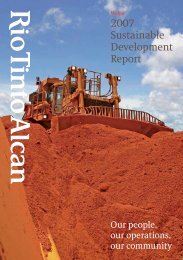Embley
Marine - part 1 (PDF 960 KB) - Rio Tinto Alcan
Marine - part 1 (PDF 960 KB) - Rio Tinto Alcan
- No tags were found...
You also want an ePaper? Increase the reach of your titles
YUMPU automatically turns print PDFs into web optimized ePapers that Google loves.
Rio Tinto AlcanEnvironmental Impact StatementSouth of <strong>Embley</strong> ProjectTable 6-2 Benthic Habitat SurveysLocationNumber ofTowed Transects orDrop Video Drift SitesMethodSurvey dateProposed disposal ground 18 Towed sled Oct 07Mounds areas (10km WNW from the port) 9 Towed sled Oct 07Proposed port area 9 Towed sled Oct 07Sub-tidal soft reef area (150m south of theport)9 Drop video Oct 07Hey River Terminal Preliminary inspection Drop video Oct 07Hey River Terminal 10 Drop video Nov 08Hey River Terminal 12 Drop video June 09Hornibrook Terminal Preliminary inspection Drop video June 08Hornibrook Terminal 11 Drop video June 09Humbug Terminal Preliminary inspection Drop video June 08Humbug Terminal 7 Drop video June 08Pera Head** Preliminary inspection Drop video Oct 07Pera Head 299 (points on grid) Drop video June 08Boyd Point** Preliminary inspection Drop video Oct 07Boyd Point 114 (points on grid) Drop video June 08Pera Head to Thud Point 19 Drop video June 10Port area departure channel 20 Drop video June 10Nine Mile Reef 4 Drop video June 10** Preliminary inspection following identification of hard coral reefs6.3.1.2 Dominant Reef Habitat SurveysThe distribution of dominant reef habitat types (hard coral or soft -coral sponge) betweenBoyd Point and Thud Point were determined through site inspection following inference fromavailable bathymetric charts, bathymetric survey commissioned by RTA and interpreted aerialphotography. Slope analysis overlain with detailed contour information was also applied toassist in the delineation of reef patches. Drop camera video inspection was undertaken at PeraHead and Thud Point to assist in confirming the inferred presence of these reef areas. Detaileddrop camera video surveys (described below) in 2007 and 2008 had already confirmed theextent of reef habitats at Pera Head and Boyd Point.Drop camera video inspection was also undertaken from Nine Mile Reef approximately 6kmsouth-south-west of the proposed disposal ground. This is the nearest substantial seabedfeature to the proposed spoil ground.Inspection of potential reef habitat south of Thud point was not undertaken due to the very lowlikelihood of turbid plumes extending inshore beyond Thud Point. This was confirmed throughturbid plume modelling (refer to Section 6.9.2.2).6.3.2 Inshore and Offshore Reef HabitatsWhile the vast majority of the Gulf of Carpentaria consists of open sandy and muddy habitats,some reef habitat occurs. Fringing and nearshore reefs occur on many parts of western CapeYork and are recorded in parts of Albatross Bay, including much of the southern foreshore andJantz /Duyfken Point (Baker and Sheppard 2006), but are generally poorly mapped.The iron stone formations present along the western Cape York shoreline support thedevelopment of shallow fringing hard coral and soft benthos reef communities. Reef habitatsimilar to what is present within the Project area is located approximately 75km to the north ofAlbatross Bay, in the vicinity of the mouth of Port Musgrave (refer Figure 1-1 for regionalmap). Dog Reef extends approximately 7km to the south of the mouth of Port Musgrave andSection 6 Marine Page 6-18



